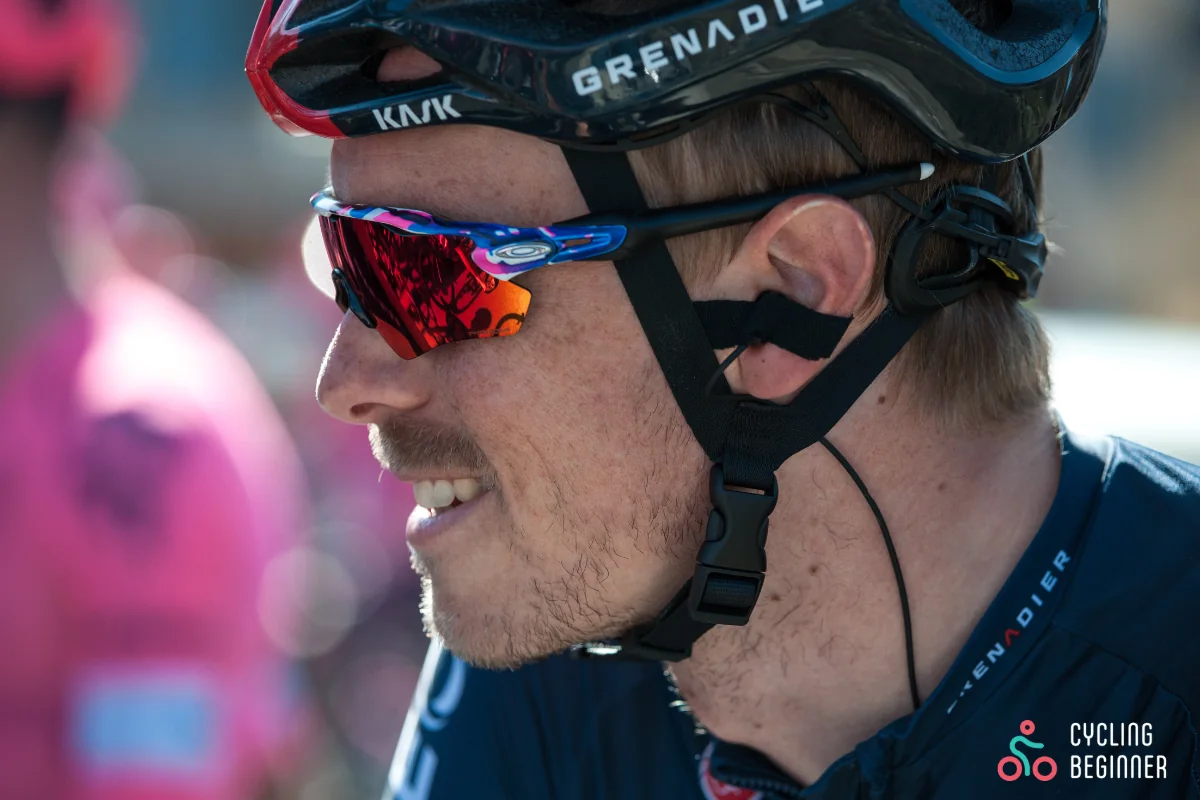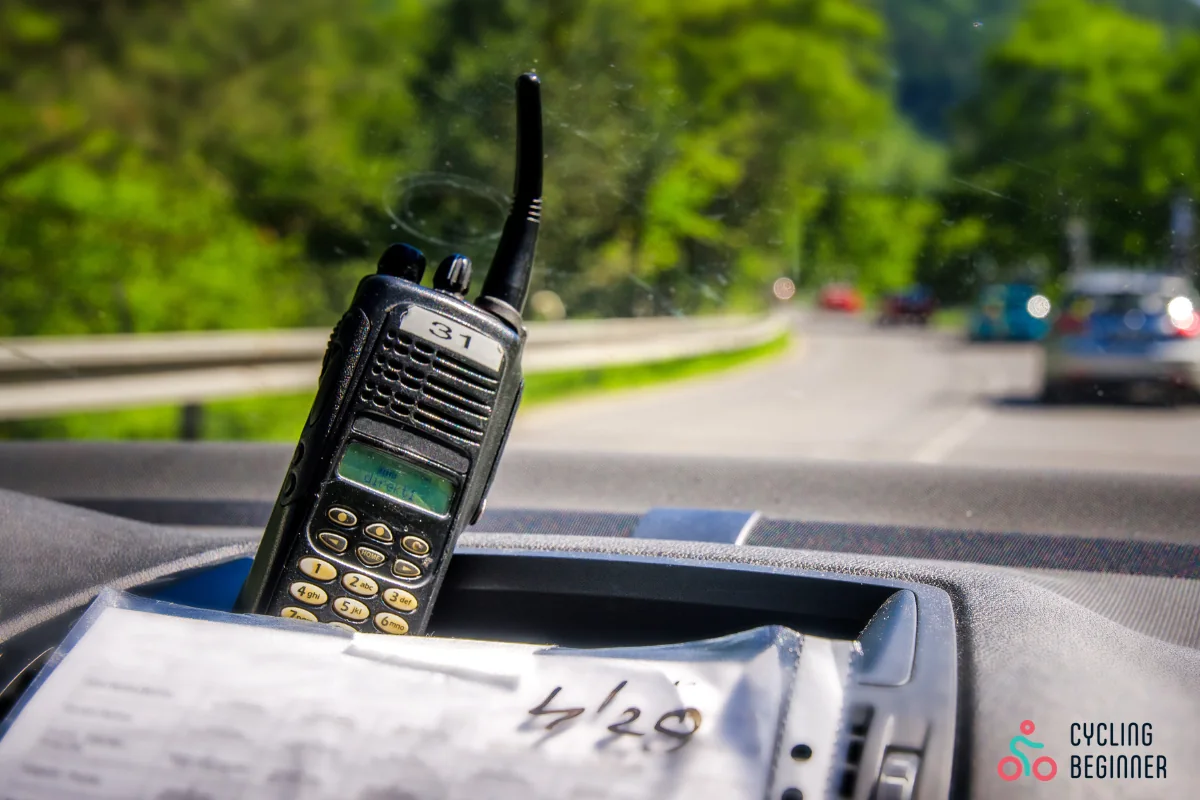If you’ve ever watched a bike race, you’ve probably noticed that the riders have an earpiece in their ears. No, they don’t have it to pass the time by listening to music.
In cycling races, two-way radio communication is set up between the riders and the team car. Cyclists wear an earpiece to receive information from the sports director in the car. They also have a microphone to reply to messages and to communicate with the other riders.
Below, we’ll dive deeper into cycling race communication. We’ll look at how it works, what equipment is used and how much the setup costs.
How does communication work in races?
Although cyclists rely on instinct at key moments in a race, communication is still a key part of cycling. The more information a cyclist has, the easier it is to make the right decision.
The riders communicate with the sports director in the team car via a small radio attached to the inside pocket of their jersey. It weighs about 200 grams, making it one of the lightest pieces of cycling equipment.
The radio offers two-way communication between the riders and the sports director.
The radio has an earpiece with a microphone, which cyclists wear in one ear only. They often tape the earpiece to their ears to ensure it doesn’t fall out during a race.
A microphone attached to the earpiece cable is tucked under the cycling jersey. At the push of a button, cyclists can talk to the sports director or other cyclists, but communication between riders via radio is rare.

The most important communication is from the team car to the riders.
The sports director has a radio base in the car. This allows communication with all riders at the same time, while the message is also heard in the other team car that’s part of the race.
The radio does not allow communication with each individual cyclist. For this, the cyclist still has to physically get to the car.
The downside of communicating with all the riders at once is that the rider who is dropped is still getting information intended for those at the front of the race. In such cases, the dropped rider usually removes the earpiece from his ear.
Inside the team car, you’ll find another radio. This one is used for communication between the two cars that each team has in a race. The staff in the cars have to be in contact throughout the race and make decisions such as which car goes with the breakaway and which stays behind the main group.
Can cyclists communicate with each other over the radio?
Riders from the same team usually stick together in a race. But sometimes, they get ‘lost’ in the peloton, and normal man-to-man communication is no longer possible.
Then, they have to rely on radio communication. The radio lets them do this, but all the riders and the sports director hear the message.
Another problem with communicating over the radio is that the microphone also picks up the sound of the wind, making it harder to understand the message. In this respect, the clearest messages come from the car, so the sports director usually repeats the cyclist’s message for the other cyclist.
What is being communicated over the radio?
The radio is not used in the race for light-hearted chats between team members. Only messages that are vital for the race are sent over the radio.
At the Tour de France 2023, for the first time, viewers were able to hear some of the messages communicated over the radio. This gave us at least some insight into what sports directors are saying to the riders.

Most of the time, it is words of encouragement combined with instructions on how to race. Any changes in tactics or riding style are given to all riders at the same time over the radio.
At the start of the race, the sports director informs the riders of the cyclists who are in the breakaway.
Perhaps one of the most important radio messages is the information about the route, especially at the end of the stages. There, the sports director usually warns cyclists about corners, roundabouts and other hazards.
Guiding cyclists through the corners and the course is particularly important in a time trial. There, the sports director only talks to the cyclist on the course and tells him what to expect in the next meters.
How do teams avoid eavesdropping?
The biggest concern for teams is that the rival teams would eavesdrop on their radio conversations to get an insight into their tactics.
It seems like a pretty easy way to get access to your opponent’s information, but the reality is that it doesn’t happen.
Radio connections are secure and allow private communication within the team.
Teams do not eavesdrop on each other. Perhaps partly because of the gentleman’s agreement that still very much exists in cycling. But in the first place, eavesdropping is not possible because each team has its own radio frequency.
Teams have different frequencies in different countries where the races are held. This means that no other team can use these frequencies, ensuring the privacy of radio communications.
In addition to preventing eavesdropping, the use of separate frequencies helps avoid frequency interference.
Are radios allowed in all races?
The radio is certainly a great asset for cyclists. But the UCI, cycling’s governing body, felt that they might be too much of an advantage for cycling, so in 2015, they wanted to ban radios but changed their decision after cyclists objected.
So radios are still allowed in most of the races, but not all of them.
Radios are banned in any race where riders are competing for the national team. This means that cyclists race without radio connections at the World Championships, European Championships and Olympic Games.
But there is always an exception.
The radio ban only applies to road races. In time trials, there is a radio communication between the rider and the car behind him. This allows the cyclist to receive information about the course.
Fun little story time. The absence of radio played a decisive role in the 2021 Olympics. The group of favourites did not know that there was another cyclist ahead of them, and they could not get the information over the radio.
So Anna Kiesenhofer unexpectedly won the gold medal, while the chasers fought for places from second onwards.
Annemiek van Vleuten, who finished second, celebrated win when she crossed the finish line, only to realized that Anna Kiesenhofer had already finish ahead of her.
What communication equipment do the teams use?
Since being introduced in the early 1990s, radios have quickly become an important part of cycling. Cyclists could suddenly communicate with team cars without dropping back, which helped them save some energy.
The equipment has not changed much since it was first used. There have clearly been some technological advances, but the basic equipment is still quite similar.
The equipment used by the teams is pretty standard and available to general public.
Cyclists carry a small handheld radio, something like a walkie-talkie, with them during the race. It’s a radio that anyone can buy on Amazon. Motorola and Hytera radios are often used, but teams also use others.

Earpieces are also fairly standard, the only requirement is that they also have a microphone. Some cyclists prefer a headset that hooks to the ear, while others prefer a regular headset that they can tape to their ear.
The biggest piece of communication equipment is certainly the base that the sports director has in the car. It allows simultaneous communication with all riders. Due to its importance and size, it is also the most expensive piece of communication equipment.
How much does communication equipment cost?
The team’s communication equipment is not the cheapest on the market, but it is not the most expensive either. The prices are ridiculously low compared to the teams’ cycling equipment cost.
The team usually owns three sets of equipment, with one set consisting of a base, a microphone and 10 radios and earpieces. A maximum of eight riders can compete in a race, and each rider needs their own radio, with the team having a few more as a backup.
One set will set a team back $4500, while all the communication equipment they need for races will take around $13,500 out of their yearly budget.
What is the range of the radios?
A group of riders can get quite stretched out on some races. Breakaway can get a lead of a few minutes over the peloton, or a rider drops a few minutes behind.
All this can make communication difficult, as the team has to decide who to prioritize communication with.
The radio can reach cyclists 4-5 minutes ahead of the car on flat terrain. The signal is weaker in the mountains, and the car needs to be closer to the cyclists.
The team car will move ahead of the peloton and follow the breakaway whenever the advantage of the breakaway is more than 1 minute. This allows it to communicate with the breakaway rider, and at the same time, it can provide him with water and energy gels when needed.

